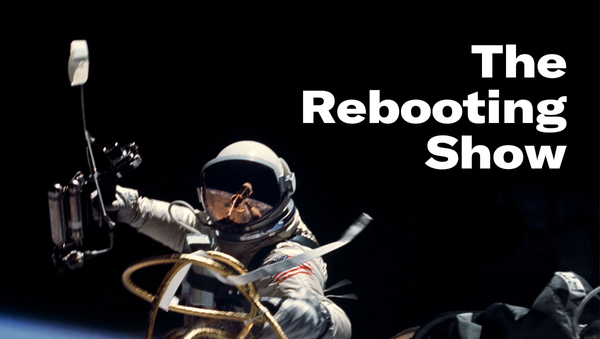Gary in Chicago
Time for headwinds

Wartime Zuckerberg is back. I have always felt that he is at his best when the pressure is on rather than when he’s doing weird hoverboard videos, killing animals with his own hands, or smoking meats with his bros. Earlier this week, in anticipation of a rough earnings report that showed revenue declined year-over-year for the first time in the company’s history, he put Meta on wartime footing in a company-wide meeting, coming just a few weeks after he bluntly told staffers that “there are a bunch of people at the company who shouldn’t be here.” Tense. That’s when Gary in Chicago entered the picture, asking about the fate of extra time off, aka “Meta days,” instituted during the pandemic.
Poor Gary clearly didn’t read the room. He’s not yet come to terms with this downturn that we aren’t calling a recession but sure looks and feels like one based not just on the drumbeat of bad news about the overall economy and the rocky results across the board at major companies. Shit moves downhill. When Google, Facebook, Apple, Snap and Twitter are all feeling the pinch, the inevitable reckoning is going to happen for publishers.
- Vox is cutting 2% of its workforce (about 40 positions) and slow hiring plans. CEO Jim Bankoff cited “economic pressures.”
- Business Insider, regularly in growth mode, has a hiring freeze, and is making surgical cuts like its closure of the politics desk in the UK.
- Recurrent, which in May raised $300 million, laid off the entire staff of Mel, a publication it had only bought a year earlier.
More will follow in prioritizing efficiency over growth. Most downturns have pat phrases executives like to roll out during earnings calls and in announcements like layoffs. In the dot-com downturn, executives constantly talked about a “lack of visibility.” I took that to mean they had no idea what was happening, much less what would happen in the coming months. This time around the stock term is “headwinds.”
I think about headwinds frequently as a runner. Running teaches you to control what you can control and make peace with the rest. If you are obsessively checking the weather for the next day, you are looking for an excuse not to run. You can always find one. It’s too hot, too cold, raining or snowing, or too windy. The people who stick with running just get it done no matter the conditions (with rare exceptions because there’s no need to run in a blizzard or a hurricane).
I’ve found even experienced runners struggle with the wind. The problem is, if you run a lot you’re probably on the lighter side, and wind can blow you around and screw up your form. Like having extra weight, the wind simply makes running harder since it means you need to expend more energy to move forward. It ends up showing who just laces up their shoes and goes for a jog and who does planks and other core work because stability is what you need in wind.
The bigger challenge of wind is psychological. It’s natural for a headwind to feel unfair in some way. I’ve noticed a tendency I have to discount the impact of the wind when it’s a tailwind. Sometimes I don’t even notice it. Instead, my faster pace is chalked up to my superb fitness level. But then, you gotta make the turn to head home, and you realize that 15mph wind at your back is now in your face. Of course, the most sensible path is to accept the conditions and adapt. The choice is either stop and walk it in, or get compact, lean into the wind as best you can, shorten your stride and make progress, even if it’s slower. Efficiency becomes the focus.
It’s not all bad. Running into a headwind is basically a way to get a hill workout without having hills. Simply put, you get stronger running into a wind than with a wind at your back. And of course, the biggest benefit is developing the mentality that adverse conditions and occurrences can be overcome. Nothing is permanent.
Back in May, I wrote in “RIP good times” what to expect in the publishing industry in a recession. As that looks increasingly like a good call. It sucks when anybody loses their job. I’m not rooting for that or the impact worsening economic conditions have for many already marginalized and challenged groups. But I also believe that getting through downturns is a fitness test for organizations and people. Gary in Chicago has clearly not been doing his planks. Many companies are cutting big numbers of people because they had massive gusts at their backs and confused the reason they were moving so fast. That’s changed. “This is a period that demands more intensity, and I expect us to get more done with fewer resources,” Zuckerberg said on yesterday’s earnings call.
We tend to believe current conditions will last in perpetuity. Look at Shopify. It believed that we entered into some kind of time machine and skipped ahead five years in the expansion of e-commerce. This week it cut 10% of its workforce, while CEO Tobi Lutke said “some groups were convenient to have but too far removed from building products.” I guess hindsight is 20/20. Many publishers and others benefited greatly from the boom in crypto that’s now turning into a bust. Those fat fees for onboarding users are going to slim down after a couple trillion has been wiped off these companies’ valuations. You cannot pay the same to acquire a user when your company is worth 75% less. It’s just logic.
Big media companies covered up their own lackadaisical training by loading on debt. All sorts of crazy things get done on the financialization front when you’re in a zero interest rate environment. The valuation of all assets, including companies, were inflated. (We tend to view asset price inflation as a great thing – we’re richer! – but not when the cost of goods and services goes up.) That debt on the balance sheet is looking a lot worse now with interest rates up another .75%.
Publishers benefited indirectly from the massive amounts of stimulus injected into the economy. That stimulus created artificially high demand for goods and services, leading companies to scramble to make more of them within supply chain constraints but also to attract willing customers. Interest rates will likely keep rising to suppress demand, and advertising is a tool in service of capturing demand. Less demand, less advertising. There’s no Ad Age column about why brands need to keep spending in a downturn that is going to change that calculus.
The switch from tailwinds to headwinds will shift leverage in the battle of the bosses and the employees over the future of the office and work overall. Zuckerberg’s earlier blunt message that Facebook would “turn up the heat” on workers to get many of them to leave was refreshingly honest. For better or worse, the tech industry sets the pace. When Silicon Valley embraced remote work, so did most companies. The change in tone – expect to see benefits and work-life balance rebranded as “coddling” – will filter down well beyond Gary in Chicago.

If you’re new to The Rebooting, please sign up (for free) to receive new issues every Tuesday and Thursday.

Recommendations
The third-party cookie will be with us a bit longer. Google said it would put off the deadline for their phase-out from Chrome, with the new deadline coming in 2024. Theoretically this gives more time to test out alternatives, but it’s hard not to see this as at least partially driven by the already uncertain digital ad environment. (Kudos to Lara O’Reilly and Ryan Joe for getting the scoop.)
Prism is a newsletter-focused publication that is organizing around “parcels,” short-term collections of newsletter content tied to a specific topic over four to eight weeks. Hopefully we’ll see more experiments with newsletter formats.
Gossamer has a great interview with Hayley Nahman, writer of the Maybe Baby newsletter. One part that stood out to me was when Hayley talked about how writing her newsletter gave her a sense of autonomy she didn’t have at corporate media jobs: “It took me a while to understand that approval from a certain set of people wasn’t actually going to give me what I thought it would give me.”
I like the division of media businesses between the poles of “intent” and “attention.” (I’d argue there’s a big middle, occupied by much of the news industry, around “influence.”) Troy Young breaks down why video is again the main battleground on the attention side.
Tech doesn’t need to be the enemy of creativity. French designer Vaskange has created a truly remarkable digital painting that allows you to pinch and zoom to go deeper into an entire world.
Kyle Chayka has a smart essay on “the age of algorithmic anxiety.” Instagrams change to move away from being a social network and embrace a TikTok style feed that leans heavily on algorithmic recommendation is another reminder that tech is often used to manipulate behavior. Perhaps we’ll see a swing back to the old-fashioned concept of word of mouth.*
We are living in a golden era of doomerism. Fixating on awful and apocalyptic scenarios has moved from the sign of being a crank to the mainstream. Bad things happen and will continue to happen. But the unhealthy wallowing in pessimism, notable on Twitter but also in most news outlets, is hardly a recipe for a content life.
*This and all other recommendations were generated by a human

Thanks for reading. Send feedback to bmorrissey@gmail.com or by hitting reply to this email. Quick reminder: Fill out this five-field form if you’re interested in The Rebooting events in the fall. If you can, please recommend this newsletter to a friend or colleague who would find it useful.




